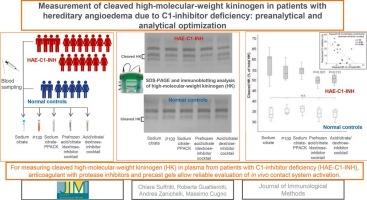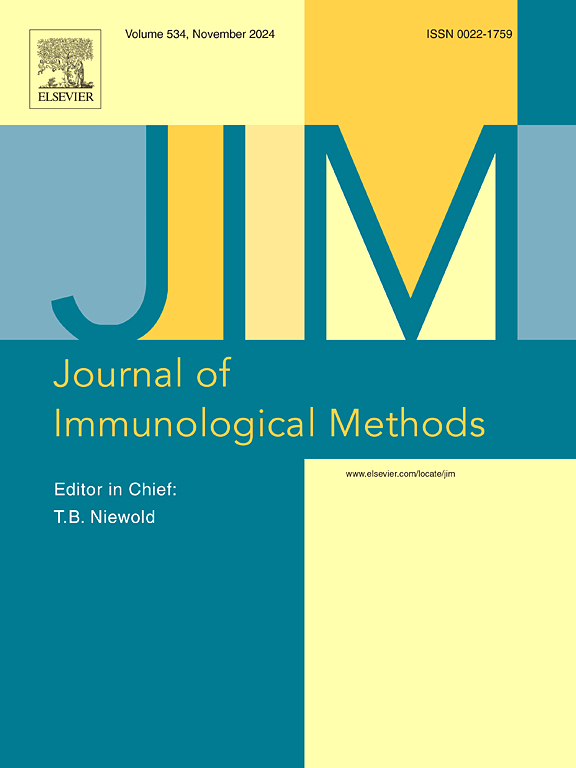Measurement of cleaved high-molecular-weight kininogen in patients with hereditary angioedema due to C1-inhibitor deficiency: preanalytical and analytical optimization
IF 1.6
4区 医学
Q4 BIOCHEMICAL RESEARCH METHODS
引用次数: 0
Abstract
High-molecular-weight kininogen (HK) is a plasma protein cleaved during the activation of contact system by the enzyme kallikrein, releasing the peptide bradykinin, potent angioedema mediator. Plasma measurement of cleaved HK allows evaluating in vivo contact system activation but, when its main natural inhibitor (C1-inhibitor) is deficient, conflicting results have been reported, possibly due to in vitro activation.
We collected blood samples from 18 patients with C1-inhibitor deficiency and 7 healthy controls using five different anticoagulant mixtures to find the one that could completely block in vitro activation of contact system, so that a snapshot of the in vivo scenario could be obtained. The ability to prevent contact system activation in vitro was evaluated in plasma samples measuring levels of cleaved HK by SDS-PAGE with precast gels and immunoblotting. Correlations between cleaved HK and functional C1-inhibitor were evaluated as well as assay reproducibility.
In healthy subjects, no differences in cleaved HK were found for the different anticoagulants. In patients with C1-inhibitor deficiency, we observed higher levels of cleaved HK in sodium citrate samples (median 60.5 %, IQR 51.9–61.6 %) than in samples collected in a mixture of protease inhibitors (median 49.2 %, IQR 48.1–52.0 %) (P = 0.001). Only in the latter, cleaved HK levels correlated with circulating functional C1-inhibitor levels (P = 0.005). Using precast gels, intra- and inter-assay coefficients of variation were < 5 %.
In conclusion, for measuring cleaved HK in plasma from patients with C1-inhibitor deficiency, the use of anticoagulant with protease inhibitors and precast gels allows reliable evaluation of in vivo contact system activation.

c1抑制剂缺乏导致的遗传性血管性水肿患者的高分子量激肽原的测定:分析前和分析优化
高分子量激肽原(high -molecular weight kininogen, HK)是一种在接触系统被缓激肽酶(kallikrein)激活时裂解的血浆蛋白,释放出缓激肽,是一种有效的血管性水肿介质。血浆测量裂解HK可以评估体内接触系统激活,但是,当其主要天然抑制剂(c1抑制剂)缺乏时,可能由于体外激活,报道了相互矛盾的结果。我们收集了18例c1抑制剂缺乏症患者和7名健康对照者的血液样本,使用5种不同的抗凝剂混合物,寻找一种可以完全阻断接触系统体外激活的抗凝剂,从而获得体内情况的快照。通过SDS-PAGE、预制凝胶和免疫印迹法测量血浆样品中裂解HK的水平,评估了体外防止接触系统激活的能力。我们评估了裂解HK与功能性c1抑制剂的相关性以及实验的重复性。在健康受试者中,不同抗凝剂的裂解性HK无差异。在c1抑制剂缺乏的患者中,我们观察到柠檬酸钠样品中裂解的HK水平(中位数为60.51 %,IQR为51.90-61.60 %)高于蛋白酶抑制剂混合物样品(中位数为49.21 %,IQR为48.10-52.05 %)(P = 0.001)。只有在后者中,裂解HK水平与循环功能c1抑制剂水平相关(P = 0.005)。使用预制凝胶,计算了测定内和测定间的变异系数
本文章由计算机程序翻译,如有差异,请以英文原文为准。
求助全文
约1分钟内获得全文
求助全文
来源期刊
CiteScore
4.10
自引率
0.00%
发文量
120
审稿时长
3 months
期刊介绍:
The Journal of Immunological Methods is devoted to covering techniques for: (1) Quantitating and detecting antibodies and/or antigens. (2) Purifying immunoglobulins, lymphokines and other molecules of the immune system. (3) Isolating antigens and other substances important in immunological processes. (4) Labelling antigens and antibodies. (5) Localizing antigens and/or antibodies in tissues and cells. (6) Detecting, and fractionating immunocompetent cells. (7) Assaying for cellular immunity. (8) Documenting cell-cell interactions. (9) Initiating immunity and unresponsiveness. (10) Transplanting tissues. (11) Studying items closely related to immunity such as complement, reticuloendothelial system and others. (12) Molecular techniques for studying immune cells and their receptors. (13) Imaging of the immune system. (14) Methods for production or their fragments in eukaryotic and prokaryotic cells.
In addition the journal will publish articles on novel methods for analysing the organization, structure and expression of genes for immunologically important molecules such as immunoglobulins, T cell receptors and accessory molecules involved in antigen recognition, processing and presentation. Submitted full length manuscripts should describe new methods of broad applicability to immunology and not simply the application of an established method to a particular substance - although papers describing such applications may be considered for publication as a short Technical Note. Review articles will also be published by the Journal of Immunological Methods. In general these manuscripts are by solicitation however anyone interested in submitting a review can contact the Reviews Editor and provide an outline of the proposed review.

 求助内容:
求助内容: 应助结果提醒方式:
应助结果提醒方式:


